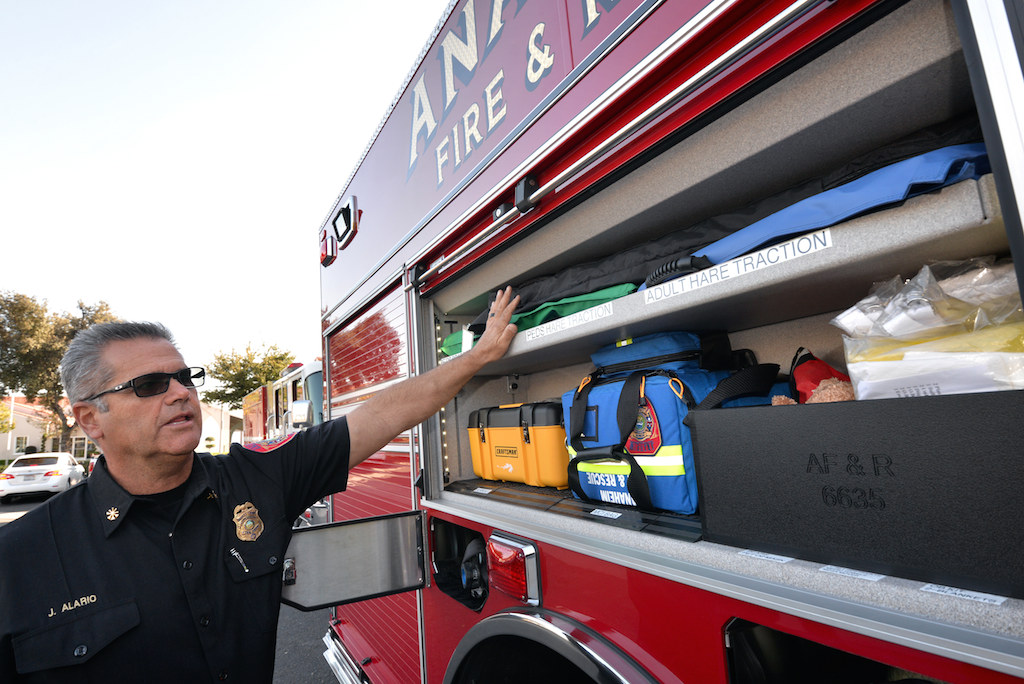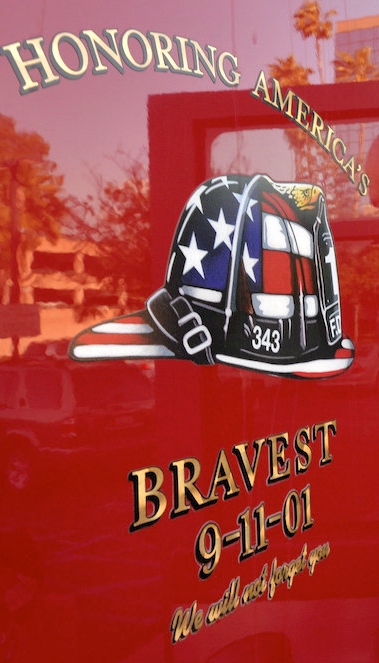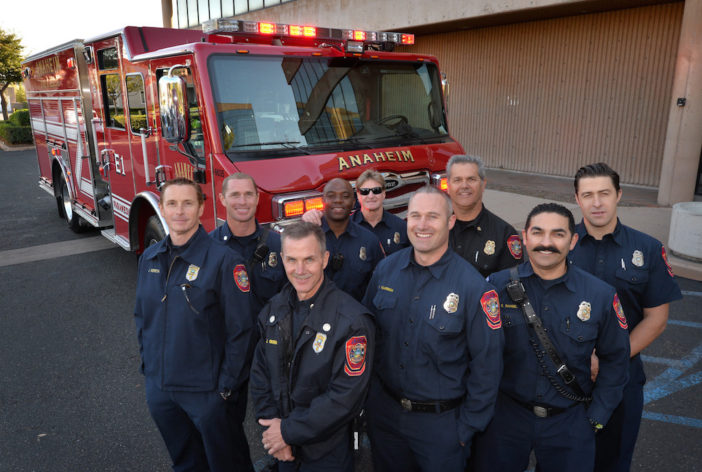They couldn’t take their eyes off of her.
Or is it a he?
Doesn’t matter.
Anaheim Fire & Rescue has two brand-new engines, and boy (girl?), are they beauties.
During a public unveiling outside City Hall on March 3, Anaheim city officials, city employees and passersby joined Anaheim firefighters to tour and admire one of the 40,000-pound, bright-red engines.
The new engines — made by Pierce Manufacturing of Appleton, Wis. — are assigned to Stations 1 and 5.
They replace two 20-year-old engines that will be used as reserved “apparatus,” the term firefighters use for engines, trucks and other rigs they drive.
Twenty years is a long time to go before replacing an engine, says Jeff Alario, deputy chief of support services for Anaheim Fire & Rescue.
Engines (and trucks) put on “hard” miles responding to the city’s nearly 33,000 calls for service each year, giving their diesel engines brutal workouts several times a shift.
Ideally, Alario says, trucks and engines are rotated out every 15 years.

Battalion Chief Rusty Coffelt gives a tour of Anaheim Fire & Rescue’s Engine 1, Anaheim’s newest addition to the department.
Photo by Steven Georges/Behind the Badge OC
So all of Anaheim Fire & Rescue is thrilled to have the new engines, which replace two 1995 apparatus manufactured by Saulsbury.
In addition to coming equipped with more modern technology and creature comforts than the older model, the new Engine 1 and Engine 5 are safer and more functional, says Alario.
He should know.
Alario led a committee that spent about 2½ years deciding how to customize the rig to AF&R’s specifications.
“It’s by far the most functional and safest firefighting apparatus we’ve ever built,” Alario says.
The new engine has a 500-horsepower diesel motor and carries 500 gallons of water, in addition to two types of foam used to douse blazes.
With a shorter wheel base and independent front suspension, the new engine has a better turning radius and is a more comfortable ride — making it easier on the backs of the four occupants and easier to get in and out of cul de sacs and other relatively tight areas.
A single windshield reduces blind spots, the side mirrors are larger and taller, and a right-hand turn camera makes it easier for the engineer (the driver) to see what’s next to the rig.

Jeff Alario, deputy chief of Support Services for Anaheim Fire & Rescue, shows where some of the supplies are kept on the new engine.
Photo by Steven Georges/Behind the Badge OC
LED lights have replaced halogen lights, whose batteries drain quicker and can melt the plastic housing if left on for too long. LED lights also are brighter.
“It’s a phenomenal piece of equipment,” Chief Randy Bruegman told the Anaheim City Council during a recent presentation of Anaheim Fire & Rescue’s strategic plan.
Alario and AF&R Battalion Chief Rusty Coffelt went over some of the other highlights of the new engine with people who stopped by to check out the new rig.
The back has a wider tailboard to make it safer to stand on, and a permanent mount ladder to improve access to the top of the rig. On the old engine, firefighters had to scramble up the back using various hand- and toeholds — increasing the risk of a misstep or fall.
The back of the new rig also has traffic advisory lights to divert cars, as well as better perimeter lighting.
Inside the engine, the captain who sits in the front passenger seat used to have to turn to the side to look at the screen of a Mobile Data Computer. The computer now sits directly in front of him, reducing back strain and related injuries.

“Honoring America’s Bravest 9-11-01, We will never forget you.” reads the side of Anaheim Fire & Rescue’s newest, Engine 1. The plan is to eventually have the 9-11 display on all of the department’s trucks and engines.
Photo by Steven Georges/Behind the Badge OC
The intercom system inside the engine has been improved, and items such as maps, radios and clipboards now are neatly stored in a plastic compartment unit between the front and rear sears.
On the outside of the rig, hoses now are accessible from all four sides of the apparatus, and a pre-connected hose has been lowered to make it easier to access.
The side of the rig is emblazoned with an emblem of a helmet and slogan honoring the 343 firefighters who perished during the World Trade Center terrorist attacks on Sept. 11, 2001.
Alario says plans are to put the emblem on all of Anaheim Fire & Rescue’s front-line apparatus within a year.
Three new rigs were paid for in the fiscal 2014-15 budget, Alario says. Another engine now is in production — it takes more than 40 days to place one engine into the production line — and the 2015-16 proposed budget allocates money for two more engines, he says.
The cost for one fully equipped engine with tools and hoses can run around $650,000.
“We had a budget to follow and are very happy with what we were able to design and build with two goals at the forefront: safety for our firefighters as well as the public,” Alario says.
“This was one of my favorite things I’ve done.”
Mayor Pro Tem Lucille Kring was very impressed during AF&R’s recent City Council workshop on the updated Strategic Plan and Standards of Cover.
Said Kring from the council dais: “It’s beautiful — it’s state-of-the-art.”
 Behind the Badge
Behind the Badge




